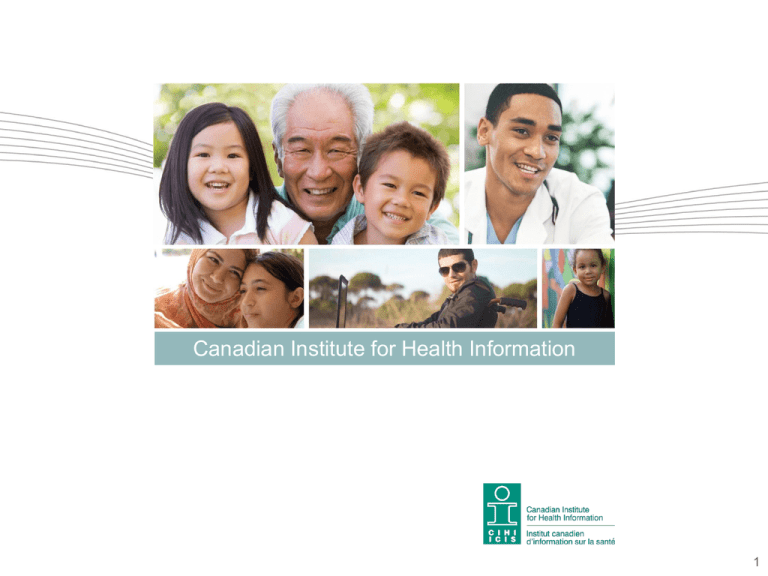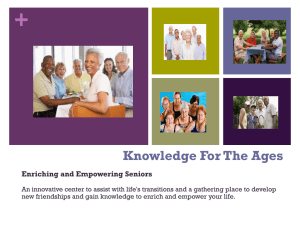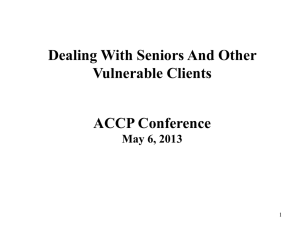Health Care in Canada, 2011: A Focus on Seniors and Aging
advertisement

Canadian Institute for Health Information 1 Health Care in Canada, 2011: A Focus on Seniors and Aging An Overview 2 HCIC 2011: A Focus on Seniors and Aging • Today’s Canadian seniors live longer and are healthier than ever before. • Seniors are frequent health system users, costing more than any other segment of the population. • In 2011, Canada’s population entered a period of accelerated aging. • Although modest to date, population aging will likely have a larger impact on the health care system in future. • The report examined seniors’ current utilization patterns and considered ways the system can adapt to meet the aging population’s future needs. 3 Accelerated Aging Proportion of Canadians age 65+ will almost double in 25 years: from 14% in 2011 to 25% in 2036. 4 Canada’s Seniors: Healthier and Living Longer • Life expectancy at age 65 continues to increase; 86.1 years for women, 82.9 years for men • Indicators of health status show a mixed picture with advancing age: Increases in . . . Decreases in . . . Chronic disease prevalence Prevalence of functional limitations Obesity rates Smoking 5 Spending Growth Lower for Seniors Between 1998 and 2008, annual increases in total per capita public-sector health expenditures were lower for seniors (5.2%) than for younger adults (6.3%). 6 Aging: One Factor in Health Spending Increases • Between 1998 and 2008, aging was a modest driver of increases in publicsector health expenditure for hospitals (1%), physicians (0.6%) and drugs (1%). • Aging has a greater impact (2.3%) on expenditures for longterm institutional care. 7 Seniors: Heavy Users of Health Care Seniors represent 14% of population, yet utilize • 45% of all provincial/territorial public-sector health spending; • 40% of acute hospital stays; • 85% of hospital-based continuing care; • 82% of home care; and • 95% of residential care. They are also more likely than younger adults to visit family doctors frequently and make claims for publicly funded prescription drugs. 8 Primary Health Care: Key to Keeping Seniors Healthy • 95% of seniors have a family physician. • 45% report same- or next-day appointments, while 34% wait 6 or more days. • 44% received no dental care in previous year, compared with 27% of adults age 45 to 64. • Seniors less likely to visit psychologists, social workers and alternative providers, compared with younger adults. 9 Prescription Drugs: Also Key to Keeping Seniors Healthy • • • With increasing age comes increased prevalence of chronic conditions, and an increasing need for prescription drugs to manage them. In 2009, 63% of seniors on public drug programs claimed ≥5 drugs from different classes, while 23% claimed ≥10. Five of the top 10 drug classes used by seniors treat high blood pressure and heart failure. 10 Drug Safety Is a Concern • In 2009, ~1 in 10 seniors were taking drugs that were potentially inappropriate. • Seniors are at increased risk of drug side-effects and interactions, compared with younger adults. Age-Sex Standardized Rate of Chronic Beers Drug Use • Seniors are more likely than younger adults to take overthe-counter drugs and supplements. Seniors in Community Settings • ~97% of formal home care recipients also have informal caregivers. • ~17% of informal caregivers report distress in their role. • Caregiver distress increases with time spent providing care. 12 Seniors in Residential Care Settings • From 1981 to 2006, rates of institutionalization among seniors have ↓, but since 2004, intensity of care provided in residential settings has ↑ • Seniors in residential care are more likely to be older (85+ years), unmarried and functionally dependent compared with those in community settings. Characteristic Descriptive Home Care HCRS (%) Residential Care CCRS (%) Age % accessed seniors pop age 85+ 40 57 Marital Status Not married 64 76 Functional Status (Activities of Daily Living) Extensive assistance/ dependence 18 74 Cognitive Performance Scale Moderate to severe 14 60 13 Room to Improve: Managing Chronic Conditions Compared with younger adults, seniors • Seek care in EDs more often •Spend more time once in EDs • Are hospitalized at higher rates for conditions sensitive to ambulatory care 14 Room to Improve: Falls Injuries Falls are the leading cause of injury hospitalizations for seniors. Care Sector Percentage of Seniors (65+) Experiencing a Fall Time Frame Acute Care 8% Prior to admission Emergency Dept 9% Prior to visit Mental Health (Inpatient) 12% 30 days prior to admission assessment Residential Care 12% Within 30 days of assessment Complex Continuing Care 7% Within 30 days of assessment Home Care 28% Within 90 days of assessment Prior to Admission Visit Within Care Setting 15 Room to Improve: Flow Across Care Settings 47% of seniors designated ALC are waiting for LTC placement. 16 Looking Ahead • In the near future, the health care system will likely need to adapt to meet the changing needs of the aging population. • Areas where decision-makers could focus include the following: 1. Improving integration across the health care continuum can lead to better care for seniors. 2. Increasing focus on prevention can help prevent or delay onset of chronic conditions and disability for seniors. 3. Adopting new health innovations and technology can help ensure that seniors are receiving appropriate care. 4. Collecting, managing, and reporting better information can better inform policy-making. 17 About CIHI’s Health Care in Canada series • Annual report first published in 2000 • Brings together data and information from many sources for broad examination of significant issue(s) • Can access entire Health Care in Canada series at www.cihi.ca/hcic (free download) • For more information, send an email to healthreports@cihi.ca. 18 Thank You 19




